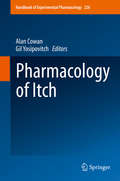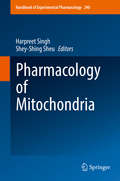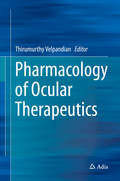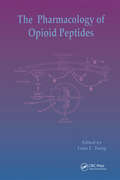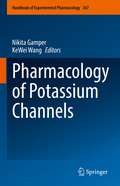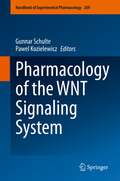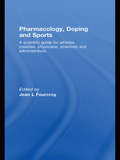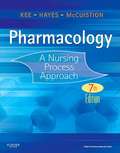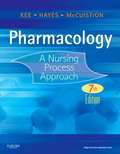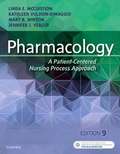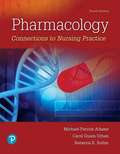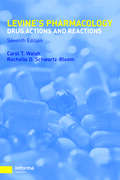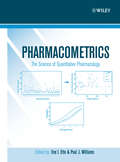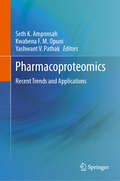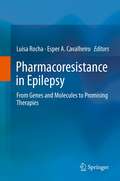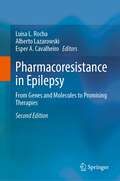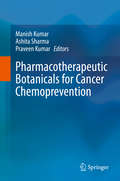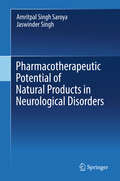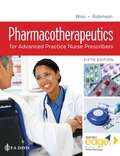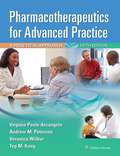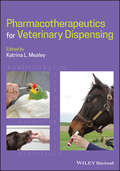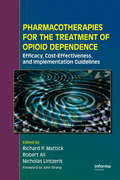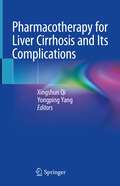- Table View
- List View
Pharmacology of Immunotherapeutic Drugs
by Clinton B. Mathias Jeremy P. McAleer Doreen E. SzollosiMedicine has entered a golden age in which therapeutic agents are becoming widely available due to advances in basic science and technology. As such, many drugs have been developed that target inflammatory processes and/or the immune system. This book is intended for health professionals examining the modulation of inflammation by immunotherapeutic drugs. The immune system fills the primordial role of host defense and resistance to infections with pathogenic microorganisms. Several hematopoietic-derived cells constituting the innate and adaptive immune systems cooperate to provide barriers for microbial colonization and/or promote pathogen destruction within the host. Conversely, many immune cells are also involved in the pathogenesis and propagation of chronic inflammatory diseases. The beginning of this book details various components of the immune system including the cell types, lymphoid tissues, soluble cytokines and surface molecules that are essential for host defense. Breakdowns in immune tolerance, or dysregulated immune responses to antigens derived from self tissues or innocuous sources, can lead to the development of autoimmunity or chronic inflammatory diseases. Pathophysiologic roles for the immune system are detailed in corresponding chapters on autoimmunity, epithelial surfaces (lungs, skin, intestine), and transplantation, with special emphasis placed on immunotherapeutic drug targets. The last section of the book focuses on treatments that stimulate our immune system to specifically target and fight infectious diseases and cancer. In each chapter, the medications used to treat various diseases/conditions in terms of their mechanism of action and other pharmacologic properties are detailed. Chapters begin with a table showing drug names and classifications. The importance of basic science and clinical trials cannot be understated in the context of drug development. As such, the discovery of certain medications that had a lasting impact in medicine and pharmacy are highlighted in chapter subsections named “Bench to Bedside.” Several clinical applications of immunotherapeutic drugs are described within end-of -chapter case studies including practice questions. The Pharmacology of Immunotherapeutic Drugs is a reference for immunologists and clinicians (medical doctors, pharmacists, nurses) examining the modulation of inflammatory processes by a variety of medications targeting the cells and mediators of our immune system.
Pharmacology of Itch
by Alan Cowan Gil YosipovitchBasic research on the pharmacology of itch has exploded in the wake of two very influential papers that were published in Nature (2007) and Science (2009). Long overlooked as a milder form of pain, itching has rapidly gained a new appreciation in both research and clinical communities because of its complexity and its negative effects on the quality of life of the distressed patients. Like pain, not all itches are the same. Unlike pain, there are no standard drugs equivalent to aspirin and morphine. Epidemiological studies emphasize the high incidence and economic costs of itch (pruritus). It is the most prevalent symptom of a wide variety of allergic and inflammatory skin conditions (e. g. , psoriasis, atopic dermatitis), is associated with several systemic diseases (e. g. , chronic kidney and liver disease), and occurs in patients undergoing hemodialysis, spinal administration of opioids, and in those suffering from AIDS. The reader will learn about the multiple pathways for itch and their interactions with pain. The relationship between these closely related, yet distinct sensory phenomena, will be emphasized. Both itch and pain use several common molecules to send signals to the brain. Thus, drugs that have been, and are being, developed as analgesics may also attenuate intractable itch. This has been an exciting and very necessary turn of events since traditional H-1 receptor antagonists are ineffective in blocking the pruritus associated with kidney failure and cholestasis. The clinical chapters will provide insights into contemporary treatment regimens for pruritus in different human scenarios.
Pharmacology of Mitochondria
by Harpreet Singh Shey-Shing SheuThis special book is conceived to highlight mitochondrial structural and functional integrity and how they are associated with several human diseases such as cardiovascular, cancer, renal, neurological disorder, and genetic disorders. The chapters contributed by leading mitochondrial researchers in the handbook will take us through the novel pharmacological strategies via mitochondria to understand their physiological and pathological role as well as present them as therapeutic targets.
Pharmacology of Ocular Therapeutics
by Thirumurthy VelpandianThis book comprises an integrated review of ocular therapeutics across all relevant fields. It addresses the real-world requirements of ophthalmologists, pharmacists and optometrists, as observed through working alongside these practitioners for two decades. Knowledge surrounding agents used in ophthalmic practice has, historically, been scattered. The book facilitates understanding of ocular drug therapy by compiling all key aspects of the pharmacology, toxicology, pharmaceutical science, ocular biochemistry and cell biology of these agents. Chapters detail drug transfer across barriers, systemic toxicity of topically applied drugs, autonomic drugs used for diagnostics, as well as anti-inflammatory, antiallergic, glaucoma and antimicrobial therapies, and avenues for the development of new ocular drugs. Applications of extemporaneously prepared formulations are described to inform day-to-day clinical practice. The use of mucoadhesive polymers in tear substitutes, ocular drug delivery systems, stem cell therapy, pharmacogenomics and antiangiogenic ocular chemotherapy are also explored. The book also provides insights from drugs of herbal origin, and a historical perspective on drugs for ocular use. Practicing and resident ophthalmologists, optometrists, pharmacists, nursing professionals, scholars in ocular drug research and students will equally benefit from this comprehensive guide.
Pharmacology of Opioid Peptides
by Leon F. TsengThis book is being published at a time when opioid receptors have recently been cloned. The structural characteristics of opioid receptors and the recent advances in their molecular cloning and expression are explicated. Connecting these cloned opioid receptors with the pharmacology of opioid receptor actions is of particular importance. The use of
Pharmacology of Potassium Channels (Handbook of Experimental Pharmacology #267)
by Nikita Gamper KeWei WangThe aim of the present book is to comprehensively review current advances in understanding of genetics, structural biology, pharmacology of potassium channels and their roles in disease as well as to identify current gaps in knowledge. The ultimate goal is to provide a scientific foundation for better understanding of modulatory mechanisms and pharmacology of potassium channels and to use this understanding to drive future drug discovery. This book will be a must-have for academic and industrial scientists interested in physiology, pharmacology, pathology and structure-functional relationships of ion channels. The book will also be helpful for lecturers and students in the college and university classrooms, as well as for anyone interested in the state-of-the art in modern cell biology, physiology and pharmacology.
Pharmacology of the WNT Signaling System (Handbook of Experimental Pharmacology #269)
by Gunnar Schulte Pawel KozielewiczThis book reflects the state of the art of our understanding of the WNT signaling system, which comprises a network of signaling pathways initiated by the secreted WNT lipoglycoproteins, which are crucial for embryonal development, stem cell regulation, tissue homeostasis and repair. Dysfunction of this evolutionarily conserved signaling system leads to many diseases including developmental disorders, diverse forms of cancer, fibrosis, neurodegenerative disease and many more. The WNT signaling system is built upon 19 mammalian, secreted WNT lipoglycoproteins that interact with a plethora of distinct receptors, such as the G protein-coupled receptors called Frizzleds (FZD1-10), LDL receptor-like proteins (LRP5/6), receptor tyrosine kinases (ROR1, 2, RYK and PTK7). In addition, WNT pathways are tightly regulated by many secreted and cell-intrinsic negative regulators, such as soluble FZD-related proteins (SFRPs), Dickkopfs (DKKs), WNT-inhibitory proteins, TIKI, RNF43 and more. Understanding the basic mechanism in terms of receptor-ligand interaction, receptor selectivity, signal initiation and desensitization remain poorly understood, even though substantial advances have been made the recent years. Due to the involvement of the WNT signaling system in human disease, it appears obvious to target diverse branches pharmacologically and therapeutically. However, given the complexity of the system and its importance for stem cell regulation and tissue maintenance, therapy comes with obvious risks for severe side effects. The field is addressing the challenge to identify suitable targets and selective compounds for therapy allowing disease-selective therapeutic effects and balancing unwanted side effects. This book summarizes the current understanding of the basic and applied pharmacology in the WNT signaling system and bridges disciplines such as pharmacology, physiology, neurosciences, oncology and drug development.
Pharmacology, Doping and Sports: A Scientific Guide for Athletes, Coaches, Physicians, Scientists and Administrators
by Jean L FourcroyThe work of dope testers is constantly being obstructed by the development of ever harder-to-trace new forms of banned substances. Organisations such as the World Anti-Doping Association and the United States Anti-Doping Agency are pioneering cutting-edge techniques designed to keep competition at the highest level fair and safe, and must ensure that their drug testing laboratories adhere to the highest scientific standards. In Pharmacology, Doping and Sports these techniques and procedures are explained by the anti-doping experts who practice them. Broad-ranging in scope, this book examines the effects of performance-enhancing substances on the athlete’s health; the role of anti-doping procedures as an ethical question, and explains the background to, and the emergence of, the anti-doping movement. The book also offers in-depth analysis of key scientific matters, such as: standard analytical and diagnostic tests for sports doping regulatory standards for laboratory proficiency common performance-enhancing techniques such as anabolic and designer steroids, blood doping, growth hormones, and gene doping carbon-isotope ratio testing. Written by some of the world's leading authorities on the science of sports doping, Pharmacology, Doping and Sports provides an invaluable study of up-to-the-minute anti-doping techniques. This book is essential reading for all sports scientists, coaches, policy-makers, students and athletes interested in the science or ethics of doping in sport.
Pharmacology: A Nursing Process Approach (7th Edition)
by Joyce Lefever Kee Evelyn R. Hayes Linda E. MccuistionFeaturing concise, straightforward coverage, Pharmacology: A Nursing Process Approach, 7th Edition puts nursing pharmacology concepts and essential drug calculation skills into a practical nursing context to prepare you for real-world drug administration responsibilities. This edition has been revised and updated with the most current nursing pharmacology information available. Innovative features such as Prototype Drug Charts, Nursing Process Summaries, an extensive math/dosage calculation section, and NCLEX Examination-style study questions make nursing pharmacology more understandable than ever. Unique! Prototype Drug Charts provide easy access to key information on dosages, contraindications, drug-lab-food interactions, pharmacokinetics, and more for more than 100 drugs. Unique! An extensive, color-coded dosage calculation section covers six methods of dosage calculation - basic formula, ratio and proportion, fractional equation, dimensional analysis, and dosing by body weight and body surface area - eliminating the need for a separate dosage calculation book. Nursing Process Summaries present client care and drug therapy within the framework of each step of the nursing process, including information on client teaching and cultural and herbal considerations. Preventing Medication Errors boxes reinforce concepts introduced in the medication safety chapter and highlight common errors that occur in clinical practice to help you ensure safe drug administration. Herbal Alerts provide a quick reference to side effects, drug interactions, and additional information for popular herbs you may encounter in practice. A fully updated bioterrorism appendix helps you recognize the clinical manifestations of bioterrorism weapons and respond with appropriate nursing care. Unique! Illustrated overviews of normal anatomy and physiology in all drug therapy chapters help you understand how drugs work in various body systems. Critical Thinking Case Studies at the end of each chapter challenge you to apply your knowledge and analytical skills to realistic client scenarios. NCLEX Study Questions for each chapter help prepare you for the growing pharmacology coverage on the NCLEX Examination. Answers are listed upside-down at the bottom of the page for quick feedback. New medication safety chapter discusses medication errors, specific nursing measures to prevent medication errors, possible consequences of medication errors to nurses, responses to errors, reporting and learning from mistakes, and related ethical issues. Enhanced NCLEX Examination-style study questions are now more application-based and include at least one alternate-item format question per chapter. Updated chapters on cultural considerations and women's health bring you the latest information on these important considerations in drug therapy. More reader-friendly and understandable than ever, this edition features helpful new photos throughout.
Pharmacology: A Nursing Process Approach 7th Edition
by Joyce Lefever Kee Evelyn R. Hayes Linda E. MccuistionFeaturing concise, straightforward coverage, Pharmacology: A Nursing Process Approach, 7th Edition puts nursing pharmacology concepts and essential drug calculation skills into a practical nursing context to prepare you for real-world drug administration responsibilities. This edition has been revised and updated with the most current nursing pharmacology information available. Innovative features such as Prototype Drug Charts, Nursing Process Summaries, an extensive math/dosage calculation section, and NCLEX® Examination-style study questions make nursing pharmacology more understandable than ever.Unique! Prototype Drug Charts provide easy access to key information on dosages, contraindications, drug-lab-food interactions, pharmacokinetics, and more for more than 100 drugs.Unique! An extensive, color-coded dosage calculation section covers six methods of dosage calculation - basic formula, ratio and proportion, fractional equation, dimensional analysis, and dosing by body weight and body surface area - eliminating the need for a separate dosage calculation book.Nursing Process Summaries present client care and drug therapy within the framework of each step of the nursing process, including information on client teaching and cultural and herbal considerations.Preventing Medication Errors boxes reinforce concepts introduced in the medication safety chapter and highlight common errors that occur in clinical practice to help you ensure safe drug administration.Herbal Alerts provide a quick reference to side effects, drug interactions, and additional information for popular herbs you may encounter in practice.A fully updated bioterrorism appendix helps you recognize the clinical manifestations of bioterrorism weapons and respond with appropriate nursing care.Unique! Illustrated overviews of normal anatomy and physiology in all drug therapy chapters help you understand how drugs work in various body systems.Critical Thinking Case Studies at the end of each chapter challenge you to apply your knowledge and analytical skills to realistic client scenarios. NCLEX® Study Questions for each chapter help prepare you for the growing pharmacology coverage on the NCLEX® Examination. Answers are listed upside-down at the bottom of the page for quick feedback.New medication safety chapter discusses medication errors, specific nursing measures to prevent medication errors, possible consequences of medication errors to nurses, responses to errors, reporting and learning from mistakes, and related ethical issues.Enhanced NCLEX® Examination-style study questions are now more application-based and include at least one alternate-item format question per chapter.Updated chapters on cultural considerations and women's health bring you the latest information on these important considerations in drug therapy. More reader-friendly and understandable than ever, this edition features helpful new photos throughout.
Pharmacology: A Patient-Centered Nursing Process Approach (Ninth Edition)
by Linda E. McCuistion Kathleen Vuljoin-DiMaggio Mary B. Winton Jennifer J. YeagerUsing a streamlined prototype approach and an emphasis on nursing care, this text makes it easy for today’s nursing students to better understand the complicated subject of pharmacology. The book’s detailed chapter on dosage calculation, the nursing process framework for drug therapy, strong QSEN focus, and summaries of prototype drugs help deliver the perfect pharmacology foundation. This new edition also features an improved overall organization, more streamlined content, updated prototype drug charts, a new chapter on transplant drugs, expanded information on cultural considerations, new and updated critical thinking case studies, and much more. In all, it’s the surest way to put your best foot forward when it comes to nursing pharmacology on the NCLEX and in practice!
Pharmacology: Connections To Nursing Practice
by Michael Adams Carol Urban Rebecca SutterA patient-centered approach to pharmacology in nursing practice Pharmacology: Connections to Nursing Practice links pharmacology to nursing practice and patient care. Features illuminate connections between pharmacology and nursing practice, from patient scenarios and practice applications, to lifespan considerations, alternative therapies, and gender and cultural influences. The use of prototype drugs helps nurses learn a vast range of medications, while organization by body systems and diseases places drugs in the context of their therapeutic applications. The 4th edition includes more than 30 new FDA-approved drugs, more than 20 new visuals clarifying concepts, and a new feature developing the clinical decision-making skills of advanced
Pharmacology: Drug Actions and Reactions
by Carol T. Walsh Rochelle D. Schwartz-BloomCompletely revised and updated, this is the seventh edition of Levine's classic pharmacology textbook. Known for it's thorough coverage and intelligent organization, the book covers the basic principles of pharmacological interactions on the human body in a way that is useful for both undergraduate and graduate students. Beginning with historical perspectives, nomenclature and definitions, the topics broaden to include sites and mechanisms of drug actions and travel to sites of action, as well as termination and elimination. The book also includes drug response and time-response relationships, response variability, drug toxicity, drug abuse, drug dependence, and more.
Pharmacometrics
by Paul J. Williams Ene I. EttePharmacometrics is the science of interpreting and describing pharmacology in a quantitative fashion. The pharmaceutical industry is integrating pharmacometrics into its drug development program, but there is a lack of and need for experienced pharmacometricians since fewer and fewer academic programs exist to train them. Pharmacometrics: The Science of Quantitative Pharmacology lays out the science of pharmacometrics and its application to drug development, evaluation, and patient pharmacotherapy, providing a comprehensive set of tools for the training and development of pharmacometricians.Edited and written by key leaders in the field, this flagship text on pharmacometrics:Integrates theory and practice to let the reader apply principles and concepts.Provides a comprehensive set of tools for training and developing expertise in the pharmacometric field.Is unique in including computer code information with the examples.This volume is an invaluable resource for all pharmacometricians, statisticians, teachers, graduate and undergraduate students in academia, industry, and regulatory agencies.
Pharmacopoeias, Drug Regulation, and Empires: Making Medicines Official in Britain’s Imperial World, 1618–1968 (Intoxicating Histories #10)
by Stuart AndersonThe word "pharmacopoeia" has come to have many meanings, although it is commonly understood to be a book describing approved compositions and standards for drugs. In 1813 the Royal College of Physicians of London considered a proposal to develop an imperial British pharmacopoeia – at a time when separate official pharmacopoeias existed for England, Scotland, and Ireland. A unified British pharmacopoeia was published in 1864, and by 1914 it was considered suitable for the whole Empire.Pharmacopoeias, Drug Regulation, and Empires traces the 350-year development of officially sanctioned pharmacopoeias across the British Empire, first from local to national pharmacopoeias, and later to a standardized pharmacopoeia that would apply throughout Britain’s imperial world. The evolution of British pharmacopoeias and the professionalization of medicine saw developments including a transition from Galenic principles to germ theory, and a shift from plant-based to chemical medicines. While other colonial powers in Europe usually imposed metropolitan pharmacopoeias across their colonies, Britain consulted with practitioners throughout its Empire. As the scope of the pharmacopoeia widened, the process of agreeing upon drug standardization became more complex and fraught. A wide range of issues was exposed, from bioprospecting and the inclusion of indigenous medicines in pharmacopoeias, to adulteration and demands for the substitution of pharmacopoeial drugs with locally available ones.Pharmacopoeias, Drug Regulation, and Empires uses the evolution of an imperial pharmacopoeia in Britain as a vehicle for exploring the hegemonic power of European colonial powers in the medical field, and the meaning of pharmacopoeia more broadly.
Pharmacoproteomics: Recent Trends and Applications
by Yashwant V. Pathak Seth K. Amponsah Kwabena F. M. OpuniThis book gives an overview of pharmacoproteomics and its clinical applications, as well as the latest information on drug mechanisms at the proteome level, the relationship between proteomics and toxicity or resistance, and how proteomics aid in discovery of new drug targets. The book also highlights recent advances in analytical methods, analysis, and interpretation of pharmacoproteomic data.Pharmacoproteomics: Recent Trends and Applications is an ideal book for those working in pharmaceutical industries, as well as scientists, health care professionals, and researchers who work in the field of genomics, pharmacology, pharmacokinetics, toxicology, and pharmaceutical chemistry.
Pharmacoresistance in Epilepsy
by Esper A. Cavalheiro Luisa RochaAlthough more than 10 new antiepileptic drugs have been developed in the past decade, epilepsy remains resistant to drug therapy in about one third of patients, many of whom struggle with the disease their entire lives. Managing these patients is a challenge and requires a structured multidisciplinary approach. The book includes chapters on all issues related to pharmacoresistance in epilepsy and describes recent developments in the pathogenesis and treatment of this disorder. It addresses abnormalities in inhibitory mechanisms, epilepsy-related changes to the immune system, development of pharmacoresistance caused by chronic exposure to antiepileptic drugs, and novel therapeutic strategies for preventing or slowing down the progression of the disease. Clinicians and basic scientists alike will find up-to-date information on the development of pharmacoesistance, as well as reviews of mechanisms associated with epilepsy that may help them consider novel strategies for preventing the development of pharmacoresistance in the first place. The book also features information on new therapeutic strategies for control of epilepsy, such as transcutaneous electrical stimulation and virtual screening of new antiepileptic drugs. Pharmacoresistance in Epilepsy: From Genes and Molecules to Promising Therapies is useful to anyone working in the field, whether they're studying epilepsy in the lab or treating it in a doctor's office."
Pharmacoresistance in Epilepsy: From Genes and Molecules to Promising Therapies
by Esper A. Cavalheiro Luisa L. Rocha Alberto LazarowskiThis new edition of Pharmacoresistance in Epilepsy addresses all issues relating to drug-resistance in epilepsy, including studies in patients as well in experimental models and presents the basis for an understanding of recent developments in the pathogenesis and treatment of this condition. Important issues associated with drug-resistant epilepsy are reviewed and updated, such as abnormalities in inhibitory mechanisms, neurotoxicity and changes the immune system associated with this disorder, and the development of drug-resistance as consequence of chronic exposure to antiseizure-medications. Considering that a major obstacle is that epilepsy associated with drug-resistance cannot be controlled with the traditional antiseizure medications, specific chapters describe therapeutic strategies to prevent or reduce the progression of the disease with complementary medical therapies, such as transcranial focal stimulation to promote neuroprotection. Pharmacoresistance in Epilepsy is a valuable resource for anyone working in the field, whether studying epilepsy in the lab or treating it in an office.
Pharmacotherapeutic Botanicals for Cancer Chemoprevention
by Manish Kumar Praveen Kumar Ashita SharmaThe book presents a comprehensive and up-to-date overview of phytochemicals as efficient cancer therapeutics. Over the last few decades there has been a paradigm shift from conventional cancer therapeutic approaches to alternative and complementary medicinal approaches especially using phytoconstituents from natural products. As such, the book provides an in-depth understanding of phytochemicals targeting diverse signaling pathways involved in cancer along with the evaluation of the cancer modulatory effects of phytochemicals. It also highlights the potential modulatory effect of single nucleotide polymorphisms (SNPs) on the cancer-associated cellular pathways and their interactions with the phytochemicals. Further, it analyzes the drug delivery methods, bioavailability of active components of botanicals, and toxicity of phytochemicals. Lastly, the book elucidates the 3D cell culture and animal models systems to analyze the beneficial effects of phytochemicals in cancer.
Pharmacotherapeutic Potential of Natural Products in Neurological Disorders
by Amritpal Singh Saroya Jaswinder SinghNatural Products have always played a pivotal role as sources for drug lead compounds. This book is aimed at providing inside purview of the scope of natural products (including herbal and marine) in the possible treatment of neurological disorders. The book explains pre-clinical neuropharmacological investigations done on herbs including Bacopa monnieri, Hypericum perforatum, Passiflora incarnata, Scutellaria baicalensis and Piper methysticum. It provides a comprehensive overview of the role of phytoconstituents like huperzine, curcumin, Salvinorin A, bioflavonoids, sulforaphane, tanshinone IIA, tetramethylpyrazine, tetrahydrocannabinol, and cannabidiol in the treatment of neurological disorders. The book provides a modern concept of herbal medications, neuropharmacology of marine bioactive products and Ayurvedic formulations, herbal drugs with abuse potential and neurotoxic mycotoxins.
Pharmacotherapeutics for Advanced Practice Nurse Prescribers
by Teri Moser Woo Marylou V. RobinsonThe Pharmacotherapeutics for Advanced Practice Nurse Prescribers text, online case studies, and Davis Edge online quizzing work together to create an interactive learning solution that helps students master the content and prepare them for their role as an Advanced Practice Nurse Prescriber. An access code inside new, printed texts unlocks Davis Edge, including online case studies and an eBook powered by VitalSource. Or, go all-digital with the purchase of the eBook version of the text that also includes access to Davis Edge and the online case studies.
Pharmacotherapeutics for Advanced Practice: A Practical Approach
by Andrew Peterson Virginia Poole Arcangelo Veronica Wilbur Jennifer A. ReinholdBe ready to prescribe and administer drugs safely and effectively, with the fully updated Pharmacotherapeutics for Advanced Practice, 5th Edition. Anchored in pharmacology and the principles of therapeutics, and written by experts in the field, this is your road map to effective drug therapies. Learn to correctly identify a disorder, review the drugs used to treat it, and select the optimal therapy. With expert direction on more than 50 common disorders, this is the ideal resource for advanced practice clinicians and students learning pharmacotherapeutics, and a go-to reference for experienced clinicians.
Pharmacotherapeutics for Veterinary Dispensing
by Katrina L. MealeyDelivers the foundational and practical knowledge required for pharmacists to become an integral part of the veterinary health care team, improving therapeutic outcome while preventing serious adverse drug reactions in veterinary patients Pharmacotherapeutics for Veterinary Dispensing enables pharmacists and pharmacy students to expand the breadth of their pharmacological knowledge to include common veterinary species. The book offers a practical yet complete resource for dispensing drugs for canine and feline patients, with additional chapters on horses, birds, reptiles, small mammals, and food animals. Edited by a globally recognized expert in veterinary pharmacology, and including chapters written by veterinarians with expertise in pharmacotherapy and pharmacists with expertise in veterinary medicine, this book is designed to help pharmacists enhance the quality of veterinary patient care. This book is the first to combine the expertise of both veterinarians and pharmacists to enable pharmacists to apply their knowledge and skills to assure optimal therapeutic outcomes for patients of all species. Pharmacotherapeutics for Veterinary Dispensing: Puts the information needed to safely dispense prescription and OTC drugs for veterinary patients at the pharmacists’ fingertips Focuses on crucial details of canine and feline pharmacotherapeutics Helps pharmacists avoid adverse drug reactions including pharmacogenomic and breed-related drug sensitivities Offers an authoritative resource written by leading veterinary pharmacy experts designed to integrate pharmacists into the veterinary healthcare team Includes crucial regulatory information unique to veterinary drug dispensing and compounding Pharmacotherapeutics for Veterinary Dispensing is an essential reference for all pharmacists and pharmacy students that might find themselves dispensing drugs to veterinary patients, as well as for veterinarians and others involved with dispensing veterinary drugs.
Pharmacotherapies for the Treatment of Opioid Dependence: Efficacy, Cost-Effectiveness and Implementation Guidelines
by Richard P. Mattick Robert Ali Nicholas LintzerisThe most comprehensive text of its kind, this book addresses both the management of opioid withdrawal and opioid maintenance therapy, and combines up-to-date reviews of the scientific literature with evidence-based clinical guidelines for all of the relevant pharmacotherapies. A unique work, Pharmacotherapies for the Treatment of Opioid Dependence
Pharmacotherapy for Liver Cirrhosis and Its Complications
by Xingshun Qi Yongping YangThis book aims to provide an updated information on different types of major and emerging drugs for managing liver cirrhosis and its complications, including acute gastroesophageal variceal bleeding, ascites, hepatic encephalopathy, liver failure, acute kidney injury, and portal venous thrombosis. The chapters are organized by drug class, such as anti-HBV drugs, anti-HCV drugs, anticoagulants, and antibiotics, etc. The clinical efficacy, indication, and contra-indication of the various drug therapies are discussed using supportive reference material from authoritative sources and published clinical trials. It will be an invaluable reference for physicians who are treating patients with liver cirrhosis, especially those presenting with acute life-threatening complications.

